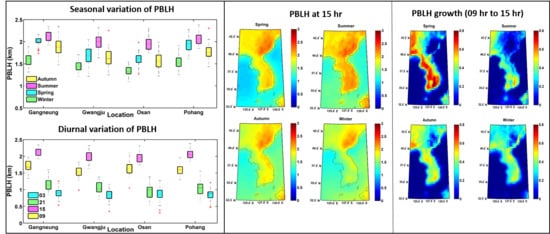Climatology of Planetary Boundary Layer Height-Controlling Meteorological Parameters Over the Korean Peninsula
Abstract
:1. Introduction
2. Data and Methods
2.1. Meteorological Data
2.2. Methods to Determine PBLH
3. Results and Discussion
3.1. Seasonal Variations of PBLH
3.2. Diurnal Variation of PBLH
3.3. Latitudinal Variability of PBLH
3.4. PBLH Growth Rate
3.5. Climatological Trends of PBLH
4. Summary and Conclusions
Supplementary Materials
Author Contributions
Funding
Acknowledgments
Conflicts of Interest
References
- Stull, R.B. An Introduction to Boundary Layer Meteorology; Kluwer Academic Publishers: Norwell, MA, USA, 1988; p. 666. [Google Scholar]
- Garratt, J.R. The atmospheric boundary layer. In Cambridge Atmospheric and Space Science Series; Cambridge University Press: Cambridge, UK, 1992; Volume 416, p. 444. [Google Scholar]
- White, A.B.; Fairall, C.W.; Wolfe, D.E. Use of 915 MHz wind profiler data to describe the diurnal variability of the mixed layer. In Proceedings of the 7th Symposium on Meteorological Observations and Instrumentations, New Orleans, LA, USA, 14–18 January 1991; pp. J161–J166. [Google Scholar]
- Allabakash, S.; Yasodha, P.; Bianco, L.; Venkatramana Reddy, S.; Srinivasulu, P.; Lim, S. Improved boundary layer height measurement using a fuzzy logic method: Diurnal and seasonal variabilities of the convective boundary layer over a tropical station. J. Geophys. Res. Atmos. 2017, 122, 9211–9232. [Google Scholar] [CrossRef]
- Basha, G.; Ratnam, M.V. Identification of atmospheric boundary layer height over a tropical station using high-resolution radiosonde refractivity profiles: Comparison with GPS radio occultation measurements. J. Geophys. Res. Atmos. 2009, 114, D16101. [Google Scholar] [CrossRef]
- Bianco, L.; Djalalova, I.V.; King, C.W.; Wilczak, J.M. Diurnal evolution and annual variability of boundary-layer height and its correlation to other meteorological variables in California’s Central Valley. Bound. Layer Meteorol. 2011, 140, 491–511. [Google Scholar] [CrossRef] [Green Version]
- Emeis, S.; Münkel, C.; Vogt, S.; Müller, W.J.; Schäfer, K. Atmospheric boundary-layer structure from simultaneous SODAR, RASS, and ceilometer measurements. Atmos. Environ. 2004, 38, 273–286. [Google Scholar] [CrossRef]
- Coulter, R.L. A comparison of three methods for measuring mixing-layer height. J. Appl. Meteorol. 1979, 18, 1495–1499. [Google Scholar] [CrossRef] [Green Version]
- Seibert, P.; Beyrich, F.; Gryning, S.E.; Joffre, S.; Rasmussen, A.; Tercier, P. Review and intercomparison of operational methods for the determination of the mixing height. Dev. Environ. Sci. 2002, 1, 569–613. [Google Scholar] [CrossRef]
- Cornman, L.B.; Goodrich, R.K.; Morse, C.S.; Ecklund, W.L. A fuzzy logic method for improved moment estimation from Doppler spectra. J. Atmos. Ocean. Technol. 1998, 15, 1287–1305. [Google Scholar] [CrossRef] [Green Version]
- Ao, Y.; Li, J.; Li, Z.; Lyu, S.; Jiang, C.; Wang, M. Relation between the atmospheric boundary layer and impact factors under severe surface thermal conditions. Adv. Meteorol. 2017, 2017, 1–12. [Google Scholar] [CrossRef]
- Basha, G.; Kishore, P.; Ratnam, M.V.; Babu, S.R.; Velicogna, I.; Jiang, J.H.; Ao, C.O. Global climatology of planetary boundary layer top obtained from multi-satellite GPS RO observations. Clim. Dyn. 2019, 52, 2385–2398. [Google Scholar] [CrossRef]
- Seidel, D.J.; Ao, C.O.; Li, K. Estimating climatological planetary boundary layer heights from radiosonde observations: Comparison of methods and uncertainty analysis. J. Geophys. Res. Atmos. 2010, 115, D16113. [Google Scholar] [CrossRef] [Green Version]
- Seidel, D.J.; Zhang, Y.; Beljaars, A.; Golaz, J.C.; Jacobson, A.R.; Medeiros, B. Climatology of the planetary boundary layer over the continental United States and Europe. J. Geophys. Res. Atmos. 2012, 117, D17106. [Google Scholar] [CrossRef]
- von Engeln, A.; Teixeira, J. A planetary boundary layer height climatology derived from ECMWF reanalysis data. J. Clim. 2013, 26, 6575–6590. [Google Scholar] [CrossRef]
- Guo, J.; Miao, Y.; Zhang, Y.; Liu, H.; Li, Z.; Zhang, W.; He, J.; Lou, M.; Yan, Y.; Bian, L.; et al. The climatology of planetary boundary layer height in China derived from radiosonde and reanalysis data. Atmos. Chem. Phys. 2016, 16, 13309–13319. [Google Scholar] [CrossRef] [Green Version]
- Guo, P.; Kuo, Y.H.; Sokolovskiy, S.V.; Lenschow, D.H. Estimating atmospheric boundary layer depth using COSMIC radio occultation data. J. Atmos. Sci. 2011, 68, 1703–1713. [Google Scholar] [CrossRef]
- De Wekker, S.F.J.; Kossmann, M.; Fielder, F. Observations of daytime mixed layer heights over mountainous terrain during the TRACT field campaign. In Proceedings of the 12th American Meteorological Society Symposium on Boundary Layers and Turbulence, Vancouver, BC, Canada, 28 July–1 August 1997; pp. 498–499. [Google Scholar]
- Lieman, R.; Alpert, P. Investigation of the planetary boundary layer height variations over complex terrain. Bound. Layer Meteorol. 1993, 62, 129–142. [Google Scholar] [CrossRef]
- Kalthoff, N.; Binder, H.J.; Kossmann, M.; Vögtlin, R.; Corsmeier, U.; Fiedler, F.; Schlager, H. Temporal evolution and spatial variation of the boundary layer over complex terrain. Atmos. Environ. 1998, 32, 1179–1194. [Google Scholar] [CrossRef]
- De Wekker, S.F.; Kossmann, M. Convective boundary layer heights over mountainous terrain—A review of concepts. Front. Earth Sci. 2015, 3, 77. [Google Scholar] [CrossRef] [Green Version]
- Choi, J.S.; Baek, S.O. An approach to estimate daily maximum mixing height (DMMH) in Pohang, Osan, and Kwangju areas—Analysis of 10 years data from 1983 to 1992. J. Korea Air Pollut. Res. Assoc. 1998, 14, 379–385. [Google Scholar]
- Yoon, S.C.; Won, J.G.; Kim, S.W.; Lim, G.M. Measurement of Mixed Layer Height Using Lidar. Proceedings of the Korean Society for Atmospheric Environment. 1999, pp. 436–437. Available online: https://scholar.google.com/scholar_lookup?title=Measurement%20of%20mixed%20layer%20height%20using%20Lidar&author=S.-C.%20Yoon&author=J.-G.%20Won&author=S.-W.%20Kim&author=&author=G.-M.%20Lim&publication_year=1999 (accessed on 8 August 2020).
- Lee, S.J.; Kawai, H. Mixing depth estimation from operational JMA and KMA wind-profiler data and its preliminary applications: Examples from four selected sites. J. Meteorol. Soc. Jpn. Ser. II 2011, 89, 15–28. [Google Scholar] [CrossRef] [Green Version]
- Lee, S.J.; Kim, J.; Cho, C.H. An automated monitoring of atmospheric mixing height from routine radiosonde profiles over South Korea using a web-based data transfer method. Environ. Monitor. Assess. 2014, 186, 3253–3263. [Google Scholar] [CrossRef]
- Lee, S.J.; Lee, J.; Greybush, S.J.; Kang, M.; Kim, J. Spatial and temporal variation in PBL height over the Korean Peninsula in the KMA operational regional model. Adv. Meteorol. 2013, 2013, 1–16. [Google Scholar] [CrossRef]
- Hersbach, H.; Dee, D. ERA5 reanalysis is in production. ECMWF Newslett. 2016, 147, 7. [Google Scholar]
- Slingo, J.M. The development and verification of a cloud prediction scheme for the ECMWF model. Q. J. R. Meteorol. Soc. 1987, 113, 899–927. [Google Scholar] [CrossRef]
- Sokolovskiy, S.; Kuo, Y.H.; Rocken, C.; Schreiner, W.S.; Hunt, D.; Anthes, R.A. Monitoring the atmospheric boundary layer by GPS radio occultation signals recorded in the open-loop mode. Geophys. Res. Lett. 2006, 33, L12813. [Google Scholar] [CrossRef] [Green Version]
- Davy, R. The climatology of the atmospheric boundary layer in contemporary global climate models. J. Clim. 2018, 31, 9151–9173. [Google Scholar] [CrossRef]
- Vogelezang, D.H.P.; Holtslag, A.A.M. Evaluation and model impacts of alternative boundary-layer height formulations. Bound. Layer Meteorol. 1996, 81, 245–269. [Google Scholar] [CrossRef]
- Zhang, Y.; Seidel, D.J.; Zhang, S. Trends in planetary boundary layer height over Europe. J. Clim. 2013, 26, 10071–10076. [Google Scholar] [CrossRef]
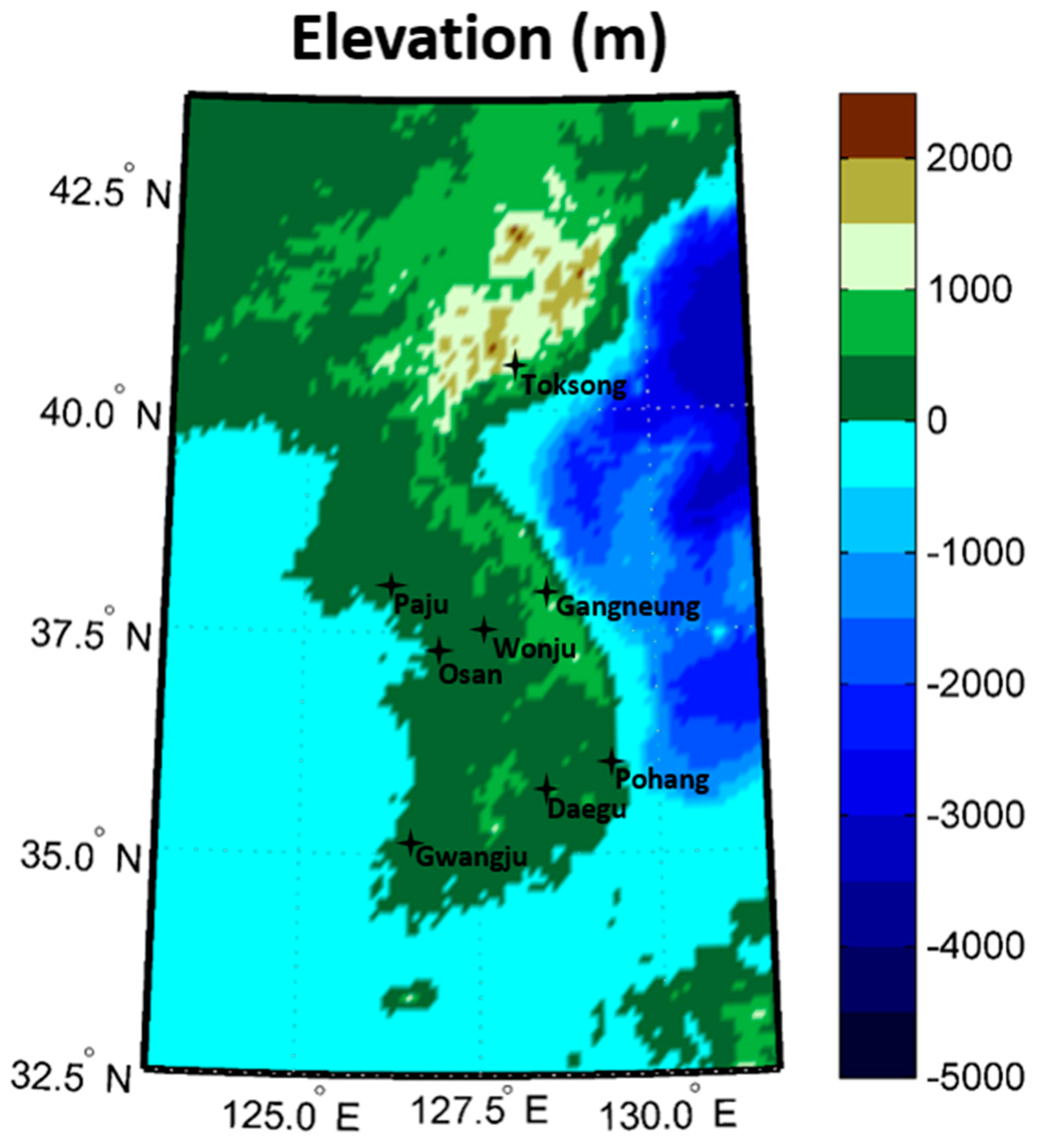
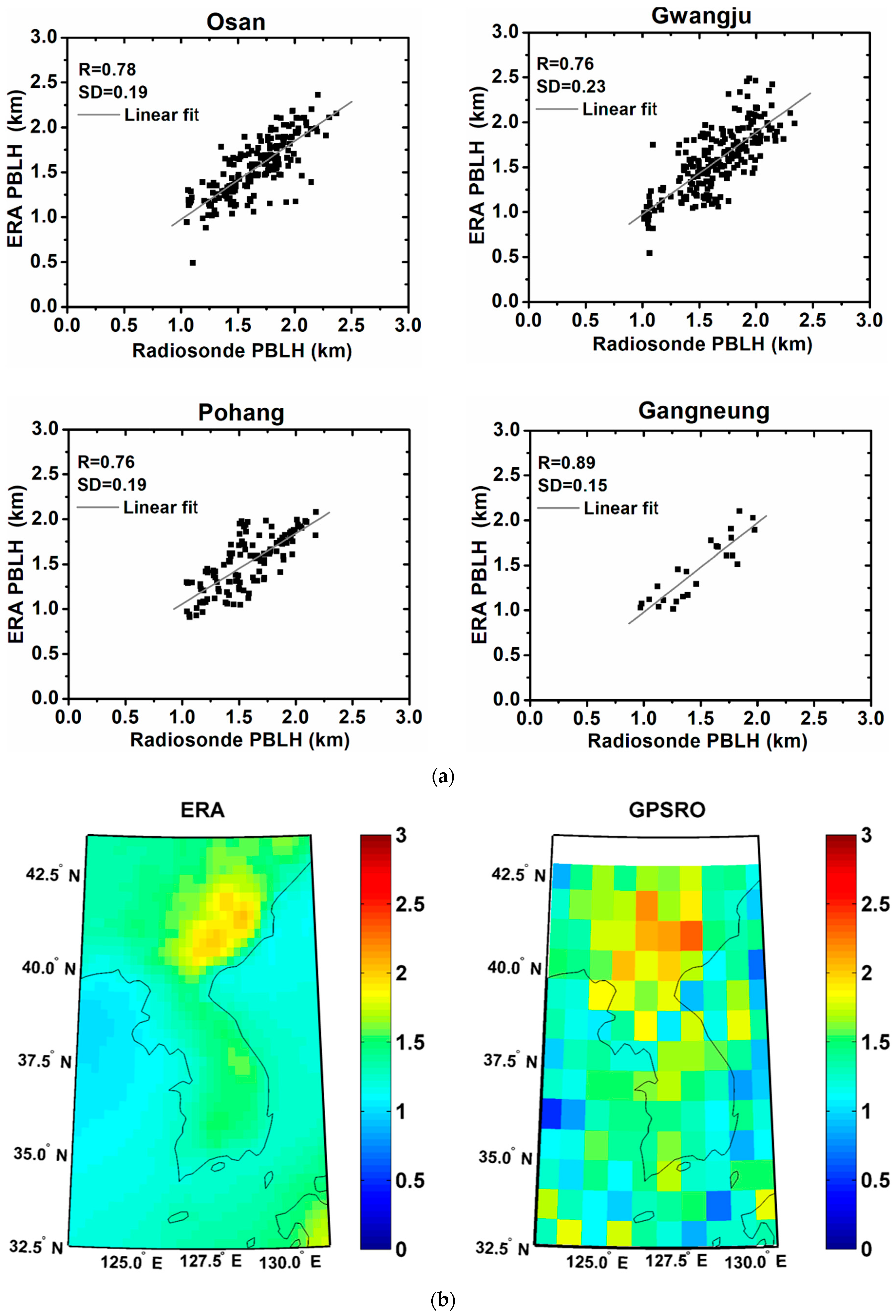
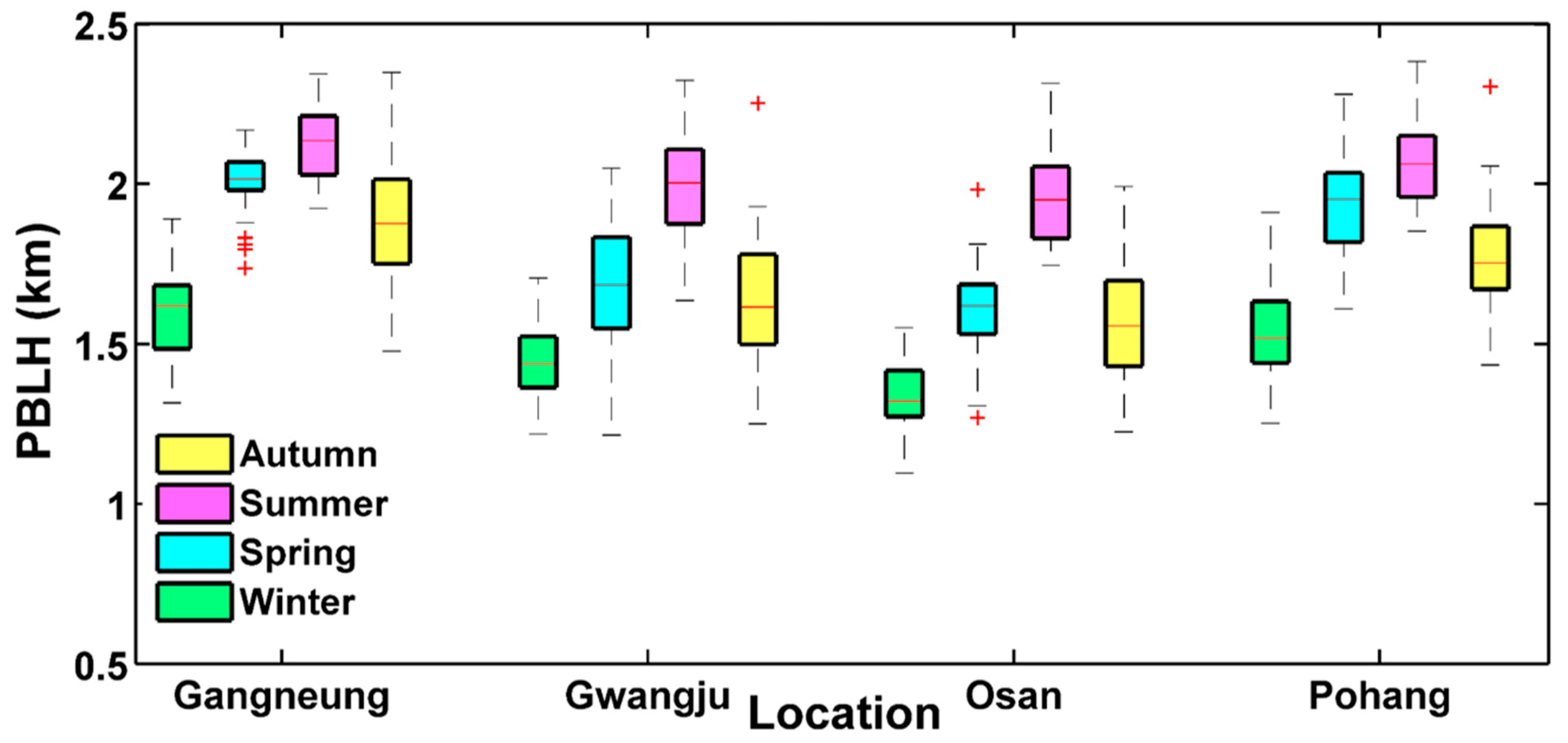



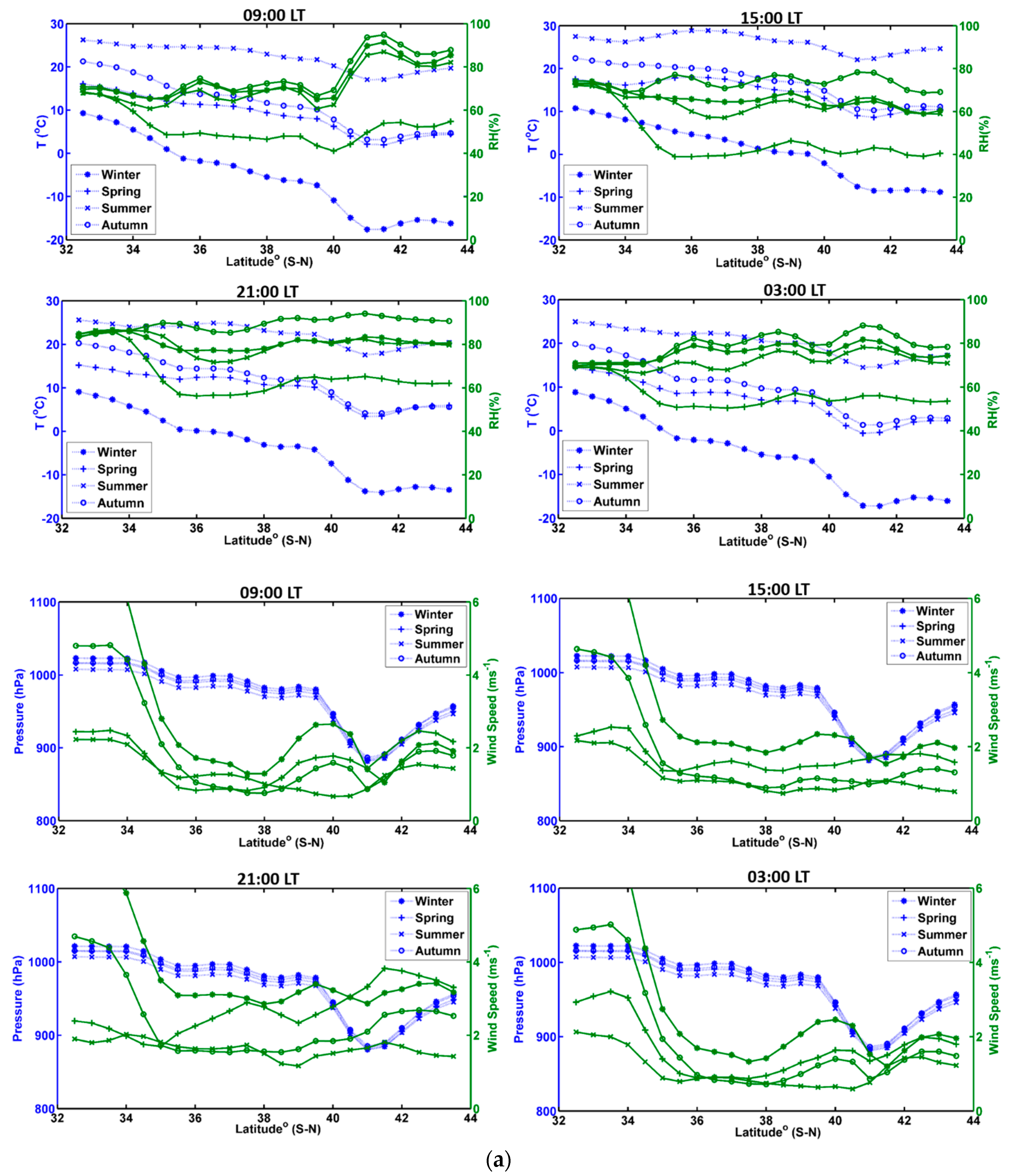


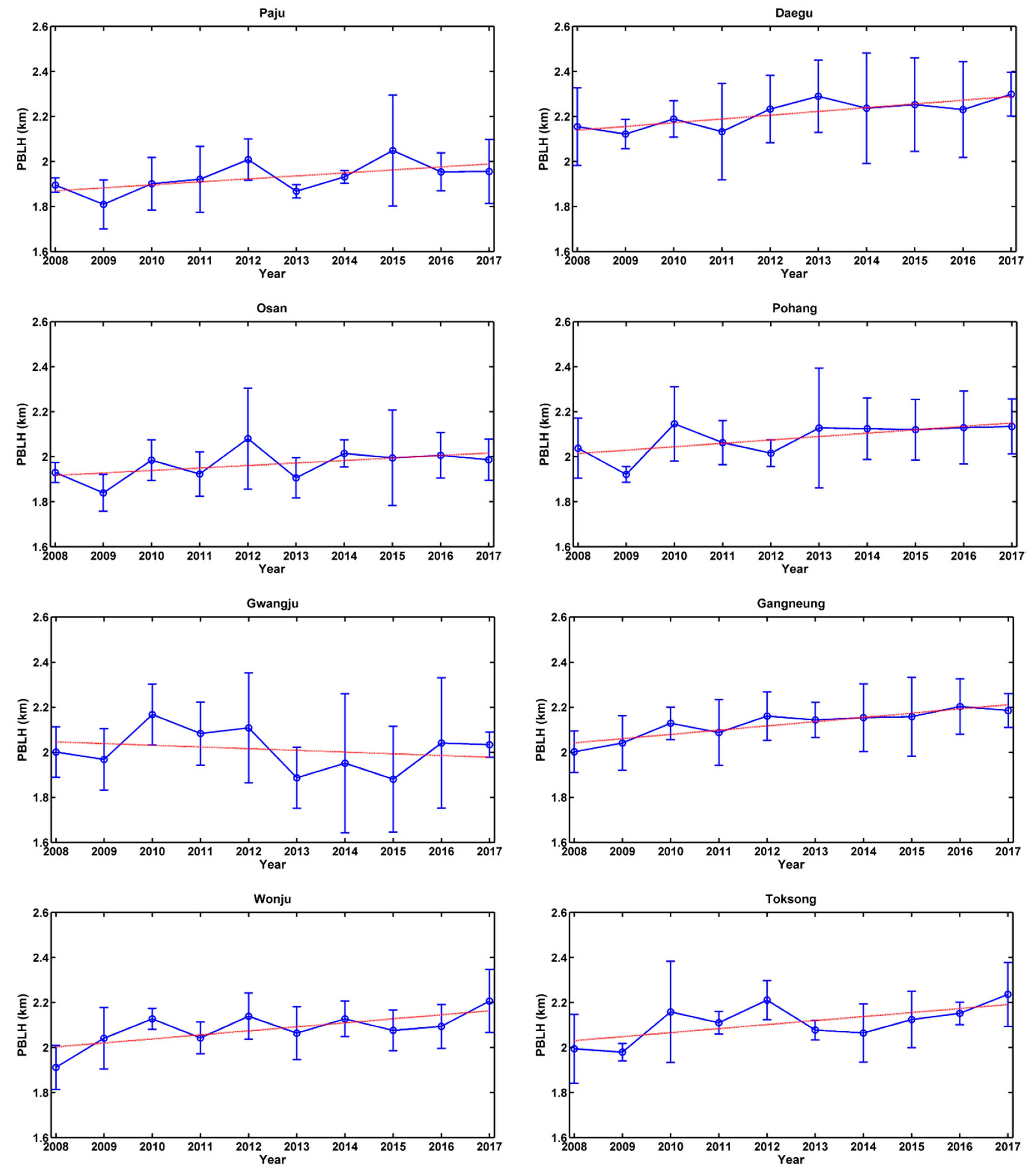


| Station | Winter (Daytime) | Winter (Nighttime) | ||||||||||||||||||
|---|---|---|---|---|---|---|---|---|---|---|---|---|---|---|---|---|---|---|---|---|
| T | RH | P | WS | LTS | T | RH | P | WS | LTS | |||||||||||
| R | SD | R | SD | R | SD | R | SD | R | SD | R | SD | R | SD | R | SD | R | SD | R | SD | |
| Osan | 0.3 | 3.4 | −0.5 | 7.5 | −0.07 | 214 | 0.5 | 0.82 | −0.5 | 2.1 | 0.07 | 2.3 | −0.4 | 4.3 | 0.1 | 195 | 0.4 | 0.4 | −0.3 | 2.0 |
| Gangneung | 0.6 | 2.6 | −0.6 | 7.9 | −0.4 | 198 | 0.03 | 0.9 | −0.6 | 1.8 | 0.2 | 2.2 | −0.2 | 6.7 | 0.2 | 180 | −0.2 | 0.7 | −0.4 | 1.6 |
| Station | Spring (Daytime) | Spring (Nighttime) | ||||||||||||||||||
|---|---|---|---|---|---|---|---|---|---|---|---|---|---|---|---|---|---|---|---|---|
| T | RH | P | WS | LTS | T | RH | P | WS | LTS | |||||||||||
| R | SD | R | SD | R | SD | R | SD | R | SD | R | SD | R | SD | R | SD | R | SD | R | SD | |
| Osan | 0.5 | 5.5 | −0.7 | 0.5 | −0.3 | 348 | 0.7 | 0.8 | −0.7 | 2.0 | −0.1 | 5.1 | −0.1 | 6.6 | 0.1 | 362 | 0.2 | 0.6 | 0.2 | 1.9 |
| Gangneung | 0.3 | 5.7 | −0.6 | 9.0 | −0.2 | 300 | −0.07 | 0.7 | −0.6 | 2.14 | −0.4 | 4.7 | −0.3 | 6.1 | 0.3 | 287 | 0.1 | 0.6 | −0.1 | 2.3 |
| Station | Summer (Daytime) | Summer (Nighttime) | ||||||||||||||||||
|---|---|---|---|---|---|---|---|---|---|---|---|---|---|---|---|---|---|---|---|---|
| T | RH | P | WS | LTS | T | RH | P | WS | LTS | |||||||||||
| R | SD | R | SD | R | SD | R | SD | R | SD | R | SD | R | SD | R | SD | R | SD | R | SD | |
| Osan | 0.4 | 2.3 | −0.1 | 13 | −0.2 | 140 | 0.3 | 0.9 | −0.05 | 2.2 | 0.6 | 1.7 | −0.03 | 8.1 | −0.04 | 119 | 0.1 | 0.6 | −0.1 | 1.6 |
| Gangneung | 0.6 | 1.8 | −0.2 | 9.8 | −0.1 | 152 | 0.1 | 0.8 | −0.2 | 1.8 | 0.6 | 1.8 | −0.09 | 5.8 | −0.07 | 143 | 0.09 | 0.6 | 0.01 | 1.8 |
| Station | Autumn (Daytime) | Autumn (Nighttime) | ||||||||||||||||||
|---|---|---|---|---|---|---|---|---|---|---|---|---|---|---|---|---|---|---|---|---|
| T | RH | P | WS | LTS | T | RH | P | WS | LTS | |||||||||||
| R | SD | R | SD | R | SD | R | SD | R | SD | R | SD | R | SD | R | SD | R | SD | R | SD | |
| Osan | 0.4 | 5.9 | −0.3 | 10 | −0.3 | 341 | 0.2 | 0.7 | −0.6 | 2.3 | 0.2 | 5.5 | −0.2 | 5.6 | −0.1 | 346 | 0.1 | 0.4 | −0.2 | 1.9 |
| Gangneung | 0.5 | 4.9 | −0.2 | 11 | −0.4 | 260 | −0.2 | 1.03 | −0.4 | 1.8 | 0.03 | 5.4 | −0.2 | 7.1 | 0.2 | 261 | −0.04 | 0.8 | −0.08 | 1.5 |
| Station | Q95 | Spearman’s Correlation | |
|---|---|---|---|
| PBLH (km) | T (°C) | ||
| Paju | 2.0 | 31.1 | 0.84 |
| Osan | 2.0 | 29.9 | 0.51 |
| Gwangju | 2.1 | 29.7 | −0.23 |
| Wonju | 2.2 | 31.1 | 0.76 |
| Daegu | 2.2 | 31.9 | 0.78 |
| Pohang | 2.1 | 32.3 | 0.66 |
| Gangneung | 2.1 | 31.5 | 0.16 |
| Toksong | 2.2 | 30.4 | −0.13 |
© 2020 by the authors. Licensee MDPI, Basel, Switzerland. This article is an open access article distributed under the terms and conditions of the Creative Commons Attribution (CC BY) license (http://creativecommons.org/licenses/by/4.0/).
Share and Cite
Allabakash, S.; Lim, S. Climatology of Planetary Boundary Layer Height-Controlling Meteorological Parameters Over the Korean Peninsula. Remote Sens. 2020, 12, 2571. https://doi.org/10.3390/rs12162571
Allabakash S, Lim S. Climatology of Planetary Boundary Layer Height-Controlling Meteorological Parameters Over the Korean Peninsula. Remote Sensing. 2020; 12(16):2571. https://doi.org/10.3390/rs12162571
Chicago/Turabian StyleAllabakash, Shaik, and Sanghun Lim. 2020. "Climatology of Planetary Boundary Layer Height-Controlling Meteorological Parameters Over the Korean Peninsula" Remote Sensing 12, no. 16: 2571. https://doi.org/10.3390/rs12162571




